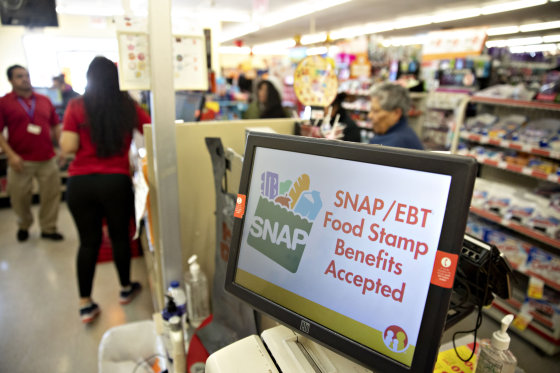The $13 billion boost in food stamp benefits in the new coronavirus aid bill isn't some kind of giveaway to people who are poor — it's some of the best stimulus government money can buy.
Economists say the new increase for food stamps, known as SNAP, for the Supplemental Nutrition Assistance Program, through June wouldn't just help those going hungry during the pandemic. It would also boost the economy more than other kinds of stimulus spending.
Every dollar spent on SNAP turns into $1.73 in economic activity, compared to $1.36 for every dollar spent on federal aid to state governments and $1.29 for every dollar allocated for a payroll tax holiday, according to Moody's Analytics researchers.
Meanwhile, cutting the corporate tax rate yields a paltry 30 cents per dollar.
"Every dollar in SNAP benefits boosts the economy," said Luis Guardia, president of the nonprofit Food Research and Action Center. "It helps strengthen the existing food supply and the mechanisms that support that."
Because people spend food stamps quickly and in their communities, which are also likely to be economically distressed, the program has a multiplier effect, boosting local businesses and economies.
The U.S. Agriculture Department found that SNAP spending has 10 times the job-creation impact of other transfer payments or federal expenditures, particularly in rural areas.
Marc Jones, CEO of Homeland Stores, a chain of 80 grocery stores in Oklahoma, Kansas, Texas and Georgia, said his "food stamp business has increased noticeably" since the pandemic began.
On average across stores, the number of purchases made with food stamps has grown by 35 percent since the start of the pandemic. But in their most affected stores, food stamp usage increased by nearly 170 percent this quarter compared to last year.
"We work with our regional and local food banks quite a bit. We hear from them that they're seeing unprecedented need," Jones said.
In April, the program helped nearly 43 million Americans a month afford nutritiously sufficient diets, according to the latest government data.
SNAP benefits are based on the Agriculture Department's Thrifty Food Plan, which calculates food costs of about $40 a week for single adults, or $134.50 for a family of four.
The budget assumes shoppers can buy in bulk to get lower prices. That isn't always possible for families who live paycheck to paycheck.
Brandi Wright of Van Buren, Missouri, a mother of two, said she was facing eviction and feared "being put out on the street" before she connected with charitable aid and SNAP benefits.
"It's very scary when you have children," she said.
She said the $374 a month she gets in SNAP benefits gives her the flexibility to buy things like meat in large packages, then portion it out and freeze it.
"If you have the money to spend it, you can buy in bulk," Wright said. "Without food stamps ... I couldn't buy bulk, because I didn't have the couple hundred dollars."
Because of the pandemic, the number of Americans estimated to be at risk of going hungry has risen from 35 million to nearly 50 million, according to estimates by the nonprofit Feeding America.
Much of that new need is coming from people who've never had to reach for food stamps before.
When Henashena Hayes, 73, of Baltimore, had to abruptly shutter her day care business in the spring, she quickly realized her monthly Social Security check of just over $1,000 wouldn't be enough to cover all her bills and also buy food.
Hayes said she received some food boxes from local churches, but she said she worried about her nutrient intake, particularly because her age puts her into a higher risk category for Covid-19.
"I try to stay eating healthy," she said, but she found it difficult to get fresh fruits, vegetables and dairy products from channels that distribute primarily nonperishable groceries.
Hayes said being able to buy fresh food after she enrolled in SNAP has helped her overcome her initial qualms.
"I felt guilty, because I worked most of my life. I'm used to working and paying my own bills," she said.
"I saw it as a handout, but this is survival," she said.
